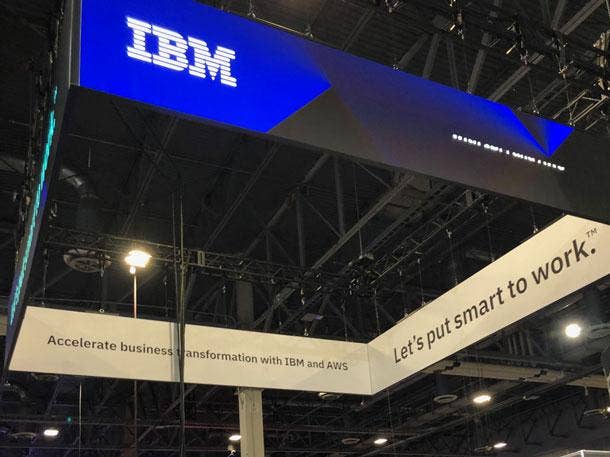Channel Chief Kate Woolley: ‘No Better Time To Be An IBM Partner’
‘As we think about the focus that IBM has on the ecosystem and the prioritization of it ... that’s what we want our partners to be seeing in terms of how they engage with IBM and and how they go forward with IBM,’ says Kate Woolley, general manager of IBM’s ecosystem.

IBM channel chief Kate Woolley said partners have seen success selling the tech giant’s offerings around data-driven insight, predictability, security and automation to customers. And to help improve partners’ relationship with IBM, the company continues to invest in new functionality for its partner portal.
Woolley shared these observations during a recent interview with CRN. She is about eight months into her role—her formal title is general manager of the Armonk, N.Y.-based tech giant’s ecosystem—with a goal of doubling ecosystem revenue in the next three to five years.
“There‘s no better time to be a channel partner,” Woolley told CRN. “And I think there’s no better time to be an IBM partner as well. As we think about the focus that IBM has on the ecosystem and the prioritization of it, and as I think about consistent focus and think about consistent revenue streams and everything like that from from the perspective of a partner—that’s what we want our partners to be seeing in terms of how they engage with IBM and and how they go forward with IBM.”
[RELATED: IBM Channel Chief Kate Woolley On Growing The Partner Ecosystem]
Woolley presides over a recently streamlined partner organization within IBM, with global systems integrators and strategic partners including hyperscalers, infrastructure partners, global consulting firms, large ISVs and technology partners now reporting to IBM’s channel chief, along with other IBM ecosystem businesses such as smaller ISVs, developer advocacy, channel partners and ecosystem engineering.
IBM has more than 55,000 partners today and is working to expand the base. To meet the needs of a growing ecosystem, the company has doubled the number of its channel-facing sellers to more than 2,000.
Mark Wyllie, CEO of Boca Raton, Fla.-based IBM partner Flagship Solutions Group, recently told CRN in an interview that it’s a busy time for IBM partners, with Flagship Solutions Group working to help customers through a refresh cycle with the new Power10 servers. His business is investing in more ways to help customers adopt the power of cloud computing.
“When there’s a refresh cycle on the Power systems, there’s a pretty good bump in sales because people want the additional capacity capabilities,” Wyllie said.
“One of the things that I see with Power10 is I think the customers—while they are looking to move to the cloud—there’s still a pretty large segment of customers that want to have an on-premises aspect to their solution,” he said.
IBM’s partner portal received a significant update in April that consolidated 45 tools into one, improved the deal registration process and added more ways to engage with IBM sellers, according to the company. The portal introduced an Auto Deal Share feature to speed up delivery of qualified sales opportunities. The average time to share a deal with partners decreased from 13 days to 96 hours.
Here’s what else Woolley had to say.

How’s the new role treating you?
It’s been an exciting eight months in the role. We’ve consolidated all pieces of the ecosystem into one place within the sales organization. It’s really resonating, and it’s allowing us to continue to emphasize the focus on the ecosystem from an IBM standpoint, both internally and externally. And it’s resonating.
At the high level, it’s going very well and I’m enjoying it.
What’s your biggest takeaway over the past eight months?
I think for us, the recognition that there isn’t just one partner or one type of partner that we want to work with. And how can we actually work across all of the different types of partners—from the smallest ISV who is growing and building and embedding IBM technology to help the functionality of their own product through to the hyperscalers and how we’re doing more with them and how we can continue to do more with them, through to some of our more traditional resellers and how we can do more.
It’s been that recognition that there isn’t one size fits all. And it’s not only how can we do business with each and every one of those, but also how can we do more business across them?
In terms of the partners where we’re seeing success, I do think it’s the partners where we’ve got them embracing the IBM strategy from a hybrid cloud and AI standpoint. And where they are looking at, across our portfolio, and embracing different pieces of that to enable that platform to come to life with their clients. … When David [La Rose, IBM’s general manager of partner ecosystem, sell] and I are together with some of our resell partners, it’s interesting to just watch the dynamic change as we have these conversations about what can we do together.
And when we lead the conversation with, ‘Investment’s not a problem. Let’s talk about what you want to invest in, what we want to invest in, what that means for our business and where we‘re going to take it’—you can almost see this whole dynamic in the room change. ‘OK, great.’
We can put everything else to the side and we actually have a really productive discussion about what we want to do together and where we’re going.
And it’s been really interesting, and watching that dynamic change as we have these conversations when David and I are together with these resell partners that might have been partners for a long time, and it feels as though the conversation is changing.

What’s the reception around the revamped partner portal?
I was with a partner a few weeks ago, and it was actually the first partner I ever spoke with when I stepped into this role. And then I spoke to him, I guess, seven months later. … He said to me, ‘The partner portal makes life so much easier.’
Because actually, when I spoke to him right at the end of December, he had raised some of the challenges with the interaction [of the portal].
So I would just share that because I do think that the partner portal and the way we’re introducing functionality there is critical and is a real change in the way that we work and interact with our partners.
So we are constantly introducing functionality. And it’s an agile road map. So as we get feedback from our partners, we can change where we’re focused in a very agile way and reprioritize the backlog of functionality and features that we want to be adding to that.
Also, we’re obviously internally undergoing a transformation with the IBM sales cloud, which is the IBM side of the partner portal.
And so having these things happen at the same time, and the functionality in those, and one of the key functionalities that is really picking up steam at the moment is around how we share opportunities between IBMers and our partners.
So click of a button, engage a partner or an IBM seller, have an opportunity. [The portal says when] it’s right for us to engage a partner here, it makes sense—that can be shared [with a] click of a button with an AI engine, suggesting the partners that would make most sense for this opportunity.
Or, if the IBM seller has a different partner, they can choose that partner. But the AI engine based on win rates, product, skills—all of that type of thing that you’d feed into that type of AI engine—it’s that functionality that is really starting to gain some momentum.

What advice do you have for IBM partners?
I do think it is leveraging IBM’s strategy and what we’re seeing resonating with our clients and our partners’ clients in terms of IBM strategy.
I don’t think anyone can argue that there isn’t an enterprise in the world or a client in the world that isn’t looking for more data-driven insights and predictability. How do I take all of this data that’s being created every single day and turn that into something that’s actually helping to drive my business?
Or, we’ve all got talent shortages. We’ve all got worker shortages. How are we automating our business to allow us to do things more efficiently and effectively?
Security—how are we securing our business? You can’t say there is any company in the world that isn’t thinking about security at the moment.
And then underlying all of that, modernizing the infrastructure and the hybrid cloud infrastructure, looking at the Red Hat portfolio as well.
So I think it’s those simple levers. We would say the IBM portfolio is really resonating in the market, and we want our partners to be able to take advantage of that.
Would you say there is no better time to be an IBM channel partner?
There’s no better time to be a channel partner. And I think there’s no better time to be an IBM partner as well.
As we think about the focus that IBM has on the ecosystem and the prioritization of it, and as I think about consistent focus and think about consistent revenue streams and everything like that from from the perspective of a partner, that’s what we want our partners to be seeing in terms of how they engage with IBM and and how they go forward with IBM.

What’s fueling customer demand for IBM’s portfolio?
Digital transformation continues to be just a huge focus that we’re seeing across our clients and our and our partners’ clients. And I don’t think we’re going to see any of that slow down.
And then I think as you look at the trends that I mentioned earlier across IBM’s strategy, as you think about the digital transformation and the modernization around that, that obviously drives a lot of demand for our portfolio.
But then from a security, from a data-driven predictive analytics and from an automation standpoint, three trends that we just see continuing to accelerate across the market [are] really driving demand for IBM.
What can partners expect as IBM continues to update the portal?
I think through that partner portal, how can we continue to support our partners to be more productive in what they’re trying to do?
So part of it is giving them visibility into what business they’re doing, what they’re earning, what they could be earning.
Part of it is also helping—this is obviously functionality that’s coming—but how do we actually help partners work out where they should be spending their time?
So from a skilling standpoint, what are the products that might make sense to add to their portfolio? What are the badging or certifications that would actually make a lot of sense for them based on what we’ve seen them historically do?
So more guided paths through becoming a bigger IBM partner and growing their own business. We’re doing that. I’d say those are probably two of the biggest things that we’re driving toward from a functionality standpoint.

How important are partners to IBM’s go-to-market strategy?
IBM will not reach its growth aspirations without getting significant growth through the ecosystem.
And that is what we’re seeing and why David and I and the rest of my team have the mission that we have.
I think we have declared there are a small set of clients where IBM wants to transact with directly, and the rest we want to work with the ecosystem. Because that’s how we see we’re going to reach more and do more with all of our partners. So that continues to be absolutely the key message that we’re hearing and saying.
Are IBM’s investments in the technology of tomorrow, like quantum computing, good for the channel?
Absolutely. When you look at quantum technology and where that’s going to go and you look at what we’re going to need from a quantum safe encryption standpoint, I think we should all be excited about it and also looking at it and looking ahead. Because a lot of our clients are going to need that and are going to need that probably sooner than we think.